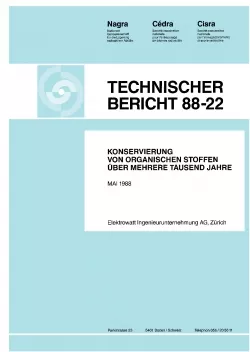
Technischer Bericht NTB 88-22
Konservierung von organischen Stoffen über mehrere Tausend JahreElektrowatt Ingenieurunternehmung AG, Zürich
Based on the current design of repositories for medium and low level radioactive waste, substantial amounts of organic substances will be a component of the waste to be deposited. Little is known regarding the potential degradation and transformation reactions of these organic substances (NTB 84-07, 85-18/-19/-20/-21, 85-43). Knowledge of the long-term behaviour of such substances is of great importance for a safety and risk assessment.
This report is the result of the joint work of archaeologists and chemists. Archaeological and (pre)historic "analogs" were used in order to evaluate the long-term stability of organic compounds. These analogs are relics, which were recovered form archaeological sites. They have a chemical composition that resembles that of the substances to be deposited in the repositories. The organics that were best suited for this study included birchtree pitch as well as resins, which served as corking, sealing and gluing materials. These organic substances are surrogates for bitumen, which is used in large quantities as a solidifying matrix for radioactive wastes. These surrogate bituminous materials, which were recovered from the archaeological sites, were analyzed and identified by gas chromatography and IR-spectroscopy. Wood samples also provide important information. Wood has been used continually over time for construction and therefore indicates the preserving properties of different soil layers. For analysis of the wood samples, the fractions of cellulose and lignin were quantified.
Wood and bituminous substances require different conditions for long-term preservation in soil. The requirements for bituminous substances are less stringent than those for wood. For example, the soil-water content of a site affects the preservation of bituminous material much less than that of wood. The stability of bituminous compounds can be estimated by the age of the recovered material, which was as old as 50'000 years. However, whether some of the chemical components originally present in these materials were lost due do degradation or leaching during storage could not be determined. Wood is preserved only under well defined environmental conditions over long periods of time. In Switzerland the oldest wood samples are from the Mesolithic period and have an age of approximately 8'000 years. Chemical analyses of such samples indicate a significantly lower cellulose content when compared to more recent wood samples.
To establish a correlation between the degree of preservation of the organic "surrogate" samples (particularly wood) and the properties of different soils, several parameters were investigated including redox potential, fraction of organic carbon, water content and pH.
The soil properties that promote the long-term preservation of organic material and wood are:
- saturation with water
- absence of dissolved oxygen, strongly negative redox potential
- low microbial activity
- low temperatures
- negligible convective transport of substances
- no disturbances
The optimal condition for preservation of organic material is a water-saturated environment, such as lake sediments or peat bogs.
